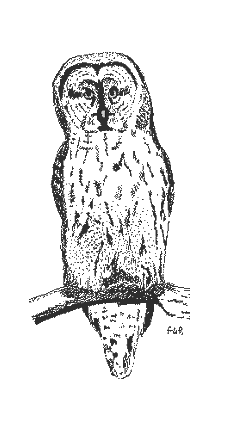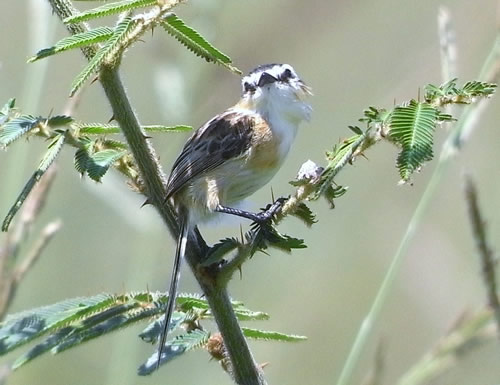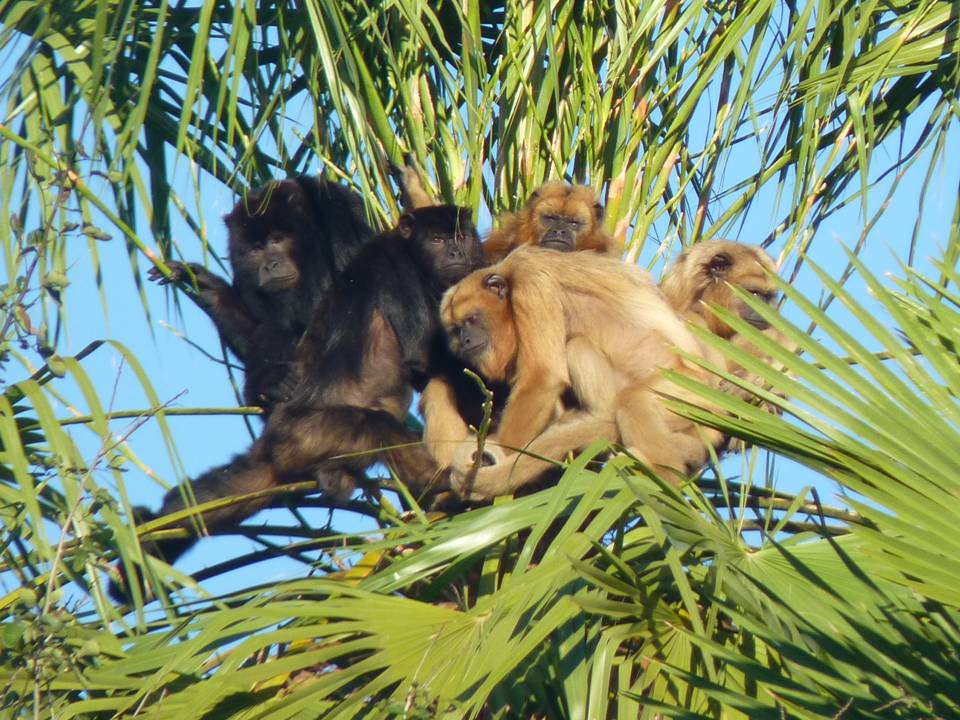Designed by Paul Smith 2006. This website is copyrighted by law.
Material contained herewith may not be used without the prior written permission of FAUNA Paraguay.
Photographs on this web-site were taken by Paul Smith and Jonathan Newman and are used with permission.
PASTIZALES DEL SUR TOUR
Introduction:
Part of a localised and threatened habitat-type known as the "Mesopotamian Flooded Grasslands", the Pastizales del Sur offer a unique opportunity for birders to concentrate on the secretive denizens that inhabit this marshy region. With possible species including the globally threatened "cappuccino " seedeaters, the stunning Saffron-cowled Blackbird and the rare Ochre-breasted Pipit, this is a tour for serious birders looking for a list of seriously localised species. A couple of days in the Atlantic Forest at San Rafael at the end will help bump up the trip list before heading back to civilsation.
Sharp-tailed Tyrant (right) Culicivora caudacuta
FAUNA Paraguay tours are recommended by:
FAUNA Paraguay eco-tours are promoted by:
|
|
|
|
 |
Birdfinders |
|
Main Targets:
Grassland specialities are on the menu. Globally-threatened species such as Ochre-breasted Pipit and Saffron-cowled Blackbird have their stronghold in this area of Paraguay and will be amongst our main targets. In wet grasslands we will look for Bearded Tachuri, Black-masked Finch, Sharp-tailed Tyrant and Lesser Grassfinch. During late October and early November migrant cappuccino seedeaters include a bunch of globally-threatened species amongst them the near threatened Dark-throated, the vulnerable Chestnut and Rufous-rumped and the endangered Marsh. After dark the bizarre Sickle-winged Nightjar will be top of the menu.
Recommended duration:
To get the best from this tour we suggest at least 9 days. A minimum of 5 days is required to complete it.
Best time to visit:
This tour is available year round but if you want a shot at the "cappuccino" seedeaters you will aim for October/November time.
Itinerary:
Day 1 - Early visit to Bahía de Asunción for a few hours birding prior to departure. After lunch proceed to Estancia La Graciela.
Day 2 - All day birding and wildlife-watching at La Graciela.
Day 3 - Continue to Ayolas, birding roadside marshes en route. .
Day 4 - Birding Isla Yacyreta. Night drive.
Day 5 - Birding marshes of Ruta 1. Arrival at Hotel Tirol.
Day 6 - Morning birding at Tirol and departure to Parque Nacional San Rafael.
Day 7 - All day birding at San Rafael. Night walk
Day 8 - All day birding at Estancia Kanguery.
Day 9 - Return to Asunción and end of services.
(Itineraries are subject to change according to levels of animal activity or client´s preference.)
What else might we see?:
With an early start we will hope to get out list off to a flyer with a few hours birding at the Bahía de Asunción. At peak times of year when the bay is awash with waders and wildfowl it is not unusual to chalk up more than 100 species in a morning. Greater Thornbird, Sharp-billed Canastero, Striped Cuckoo and White-bellied Seedeater might be amongst the birds we see in bushy areas, but serious birders will want to get their feet wet in search of skulking reedbed species that may include Bay-capped Wren-spinetail, Spotted Rail, South American Painted Snipe, Dinelli´s Doradito and Wren-like Rushbird.
From here we head to the pristine grasslands of Estancia La Graciela. Here we might expect pipits such as the threatened Ochre-breasted, but also Yellowish and with luck Short-billed or even Hellmayr´s. The near threatened Greater Rhea is easy to see here, and during passage the "cappuccino" seedeaters will be moving through - Dark-throated, Chestnut, Marsh, Rufous-rumped and Tawny-bellied. With some luck we may even catch a glimpse of the elusive Green Ibis, a bird that is easier to hear than it is to see!
En route to Ayolas we will be birding some of the roadside marshes that are always full of surprises. Long-tailed Reedfinch and Crested Doradito are usually around, whilst three handsome marsh blackbirds are possibilities - the gorgeous Scarlet-headed, the threatened Saffron-cowled and the raucous Yellow-rumped Marshbird. We´ll be listening out for skulkers such as Ash-throated and Rufous-sided Crake and Streak-backed Bittern and hoping to find the source of the voice. Other herons we will likely see include Striated, Cocoi and Whistling, as well as Great, Cattle and Snowy Egrets. Bare-faced and White-faced Ibis are usuall around, with some Roseate Spoonbills, Maguari Stork and American Wood Stork.
Isla Yacyreta is an island in the Rio Paraná that was partially flooded by the building of the Yacyreta Dam (which can be visited if interested). The wet grasslands here are a paradise for rare birds like Sharp-tailed Tyrant, Black-masked Finch, Lesser and Wedge-tailed Grassfinch and Pinnated Bittern. After dark Rufous, Little and Scissor-tailed Nightjar are around, as well as Pauraque, though our number one target will be the remarkable Sickle-winged Nightjar. Other possibilities include Stygian and Striped Owls. We´ll spend a morning birding in the forest here too principally in search of Bare-faced Currasow, though other species we might see here include Pheasant Cuckoo, Orange-headed Tanager, Olive Spinetail, Pale-crested Woodpecker and four species of becards - Grey-naped, Crested, White-winged and Green-backed.
Mammals are often encountered here too, especially Black Howler Monkey and Pampas Cavy, whilst in the forest Azara´s Agouti can be rather tame.
To break up the journey to San Rafael we will spend a night at Hotel Tirol. Its a small patch of humid forest that houses some great birds that will help keep our list growing. Eyecatching species include Chestnut-eared Aracari, Red-ruffed Fruitcrow, Surucua Trogon and Red-rumped Cacique. More patience is required for skulkers like Southern Antpipit, Plain Antvireo, Variable Antshrike, White-shouldered Fire-eye, Short-tailed Antthrush, Rufous Gnateater, Ochre-faced Tody-flycatcher, Band-tailed and Blue Manakins. In canopy flocks Blue Dacnis, Chestnut-vented Conebill, Tropical Parula, Purple-throated and Chestnut-bellied Euphonia are all possibilities.
At San Rafael we will spend one day in the forest and one day in the grasslands. In the forest Brown Tinamou, Rufous-capped and Grey-bellied Spinetail, Ochre-breasted Foliage-gleaner, Three-striped Flycatcher, Yellow-fronted, Robust and White Woodpecker, Spot-backed and Tufted Antshrike, Magpie Tanager, Saffron and Spot-billed Toucanet, Sharpbill, Plovercrest and a multitude of others will be possibilities. The more time we spend walking the trails here the more we will see. In the grasslands Sedge Wren, Cock-tailed Tyrant, Capped Seedeater, Bearded Tachuri, Red-winged Tinamou and Toco Toucan might be on our list, and after dark we will hope to see the roding Giant Snipe and maybe even owls such as Rusty-barred, Tropical and Black-capped Screech, and Black-banded.
From here we have a longish drive back to Asunción, hopefully with a very healthy list behind us.
What does it include?:
The price includes pick-up from and return to Asunción hotel, accommodation, transport, food, non-alcoholic drinks and guiding fees.
It does not include travel insurance, personal expenses, alcoholic drinks or travel costs incurred before the beginning of the tour or after return to Asunción.
For further information or to book your tour email us at faunaparaguay@yahoo.com.ar
Ask about off-season discounts (15 Feb-15 July).
Black Howler Monkey Alouatta caraya




